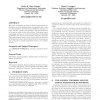Free Online Productivity Tools
i2Speak
i2Symbol
i2OCR
iTex2Img
iWeb2Print
iWeb2Shot
i2Type
iPdf2Split
iPdf2Merge
i2Bopomofo
i2Arabic
i2Style
i2Image
i2PDF
iLatex2Rtf
Sci2ools
102
click to vote
GECCO
2009
Springer
2009
Springer
Three interconnected parameters for genetic algorithms
When an optimization problem is encoded using genetic algorithms, one must address issues of population size, crossover and mutation operators and probabilities, stopping criteria, selection operator and pressure, and fitness function to be used in order to solve the problem. This paper tests a relationship between (1) crossover probability, (2) mutation probability, and (3) selection pressure using two problems. This relationship is based on the schema theorem proposed by Holland and reflects the fact that the choice of parameters and operators for genetic algorithms needs to be problem specific. Categories and Subject Descriptors I.2.6 [Artificial Intelligence]: Learning—parameter learning General Terms Algorithms, Experimentation, Measurement, Performance, Theory, Verification Keywords Performance Analysis, Empirical Study, Evolution Dynamics, Genetic Algorithms, Theory, Working Principles of Evolutionary Computing, Parameter Tuning, Schema Theorem
Artificial Intelligence | GECCO 2009 | General Terms Algorithms | Genetic Algorithms | Schema Theorem |
Related Content
| Added | 26 May 2010 |
| Updated | 26 May 2010 |
| Type | Conference |
| Year | 2009 |
| Where | GECCO |
| Authors | Pedro A. Diaz-Gomez, Dean F. Hougen |
Comments (0)

